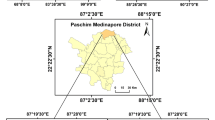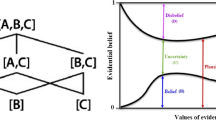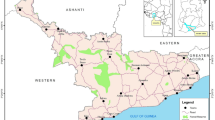Abstract
Delineation of the groundwater potential zones is one of the most essential process for the sustainable management of the groundwater sources. However, groundwater studies are quite hard and complex for many regions besides consuming time and cost. This study focused on the groundwater potential mapping in Beyşehir Lake Basin. Mainly, fuzzy-analytic hierarchy process (fuzzy-AHP) integrated with GIS was used to determine potential zones for groundwater. Seven parameters, namely lithology, lineament, drainage density, land use, slope, soil type, and rainfall were evaluated and Groundwater Potential Index (GWPI) was calculated using weight and rating coefficients of each parameter. According to obtained results, GWPI varies from 0.07665 to 0.28243 in the basin. The low, moderate, and high groundwater potential classes were determined with quantile classification method. The groundwater potential map demonstrates that the high groundwater potential area is located around the lake shore, in the alluvium and limestone fields because high permeability rates depend on soil type, low slope, karstic structure, and agricultural activities in these regions. In addition, the distribution of the springs confirms with groundwater potential area determined with this study.












Similar content being viewed by others
References
Araújo MB, Pearson RG, Thuiller W, Erhard M (2005) Validation of species–climate impact models under climate change. Glob Chang Biol 11:1504–1513
Aryafar A, Yousefi S, Ardejani FD (2013) The weight of interaction of mining activities: groundwater in environmental impact assessment using fuzzy analytical hierarchy process (FAHP). Environ Earth Sci 68(8):2313–2324
Babaoğlu M (2007) The Problems of Beyşehir Lake and Necessary Measures, Beyşehir Lake Research Commission, Konya Provincial Assembly, pp 34.
Bhushan N, Rai K (2004) Strategic decision making: applying the analytic hierarchy process. Springer-Verlag, New York, p 172
Boender CGE, De Graan JG, Lootsma FA (1989) Multicriteria decision analysis with fuzzy pairwise comparisons. Fuzzy Sets Syst 29:133–143
Buckley JJ (1985) Fuzzy hierarchical analysis. Fuzzy Sets Syst 17:233–247
Chang DY (1992) Extent analysis and synthetic decision. Optim Tech Appl 1:352
Chang DY (1996) Applications of the extent analysis method on fuzzy AHP. Eur J Oper Res 95:649–655
Chang NB, Parvathinathan G, Breeden JB (2008) Combining GIS with fuzzy multicriteria decision-making for landfill siting in a fast-growing urban region. J Environ Manag 87(1):139–153
Cheng CH (1997) Evaluating naval tactical missile systems by fuzzy AHP based on the grade value of membership function. Eur J Oper Res 96(2):343–350
Chi K, Lee BJ (1994) Extracting potential groundwater area using remotely sensed data and GIS techniques. Proceedings of the Regional Seminar on Integrated Applications of Remote Sensing and GIS for Land and Water Resources Management. Bangkok: Economic and Social Commission for Asia and the Pacific, pp. 64-69.
Chitsazan M, Akhtari Y (2009) A GIS-based DRASTIC model for assessing aquifer vulnerability in Kherran Plain, Khuzestan, Iran. Water Resour Manag 23:1137–1155
Chowdhury A, Jha MK, Chowdary VM, Mal BC (2009) Integrated remote sensing and GIS-based approach for assessing groundwater potential in West Medinipur district, West Bengal, India. Int J Remote Sens 30:231–250
Cohen J (1960) A coefficient of agreement for nominal scales. Educ Psychol Meas 20:37–46
Demirkol C, Sipahi H, Cicek S (1977) Stratigraphy and geological evolution of Sultandagı. General Directorate of Mineral Research and Exploration 6305. Ankara.
Dinesh Kumar PK, Gopinath G, Seralathan P (2007) Application of remote sensing and GIS for the demarcation of groundwater potential zones of a river basin in Kerala, southwest cost of India. Int J Remote Sens 28(24):5583–5601
Doğan A, Başayiğit L, Soyaslan İ, Nas B (2013) Determining lake-groundwater- climate relations with the help of Groundwater Flow Model and Geographic Information Systems (GIS) and creating optimum dynamic business model of the lake: a case study of Beyşehir Lake, The Scientific and Technological Research Council of Turkey (TUBITAK) Project Final Report, Project No: 109Y271, İstanbul.
Edet AE, Okereke CS, Teme SC, Esu EO (1998) Application of remote sensing data groundwater exploration: a case study of the Cross River State, Southeastern Nigeria. Hydrogeol J 6:394–404
Elewa HH, Qaddah A (2011) Groundwater potentiality mapping in the Sinai Peninsula, Egypt, using remote sensing and GIS-watershed-based modeling. Hydrogeol J 19(3):613–628
Elitok O (2000) Geology, mineralogy and petrography of Sarkikaraagac (Isparta) and vicinity. Suleyman Demirel University, Science Institute, Doctorate Thesis, 220 s. Isparta
Ganapuram S, Kumar GV, Krishna IM, Kahya E, Demirel MC (2009) Mapping of groundwater potential zones in the Musi basin using remote sensing data and GIS. Adv Eng Softw 40(7):506–518
Ghayoumian J, Saravi MM, Feiznia S, Nouri B, Malekian A (2007) Application of GIS techniques to determine areas most suitable for artificial groundwater recharge in a coastal aquifer in southern Iran. J Asian Earth Sci 30(2):364–374
Ghorbani Nejad S, Falah F, Daneshfar M, Haghizadeh A, Rahmati O (2017) Delineation of groundwater potential zones using remote sensing and GIS-based data-driven models. Geocarto Int 32(2):167–187
Gürler Ç (2017) Hydrological drought assessment with standardized index approach in the Beyşehir and Konya-Çumra-Karapınar subbasins. Ministry of Forestry and Water, General Directorate of Water Management, Master thesis, 155 p. Ankara.
Ho W (2008) Integrated analytic hierarchy process and its applications—a literature review. Eur J Oper Res 186:211–228
Jha MK, Chowdhury A, Chowdary VM, Peiffer S (2007) Groundwater management and development by integrated remote sensing and geographic information systems: prospects and constraints. Water Resour Manag 21:427–467
Kahraman C, Cebeci U, Ulukan Z (2003) Multi-criteria supplier selection using fuzzy AHP. Logist Inf Manag 16(6):382–394
Kahraman C, Cebeci U, Ruan D (2004) Multi-attribute comparison of catering service companies using fuzzy AHP: the case of Turkey. Int J Prod Econ 87:171–184
Karabörk H (2009) Selection of appropriate sampling stations in a lake through mapping. Environ Monit Assess 163(1–4):27–40
Krishnamurthy J, Srinivas G (1995) Role of geological and geomorphological factors in groundwater exploration: a study using IRS LISS data. Int J Remote Sens 16(4):2595–2618
Krishnamurthy J, Venkatesa Kumar N, Jayaraman V, Manuvel M (1996) An approach to demarcate groundwater potential zones through remote sensing and a geographical information system. Int J Remote Sens 17(10):1867–1884
Kumar P, Herath S, Avtar R, Takeuchi K (2016) Mapping of groundwater potential zones in Killinochi area, Sri Lanka, using GIS and remote sensing techniques. Sustain Water Resour Manag 2(4):419–430
Lahn E (1945) Geomorphology of the Western Taurus Lakes. J Miner Res Explor Inst 2(3):387–393
Landis JR, Koch GG (1977) The measurement of observer agreement for categorical data. Biometrics 33:159–174
Lee SK, Mogi G, Hui KS (2013) A fuzzy analytic hierarchy process(AHP)/data envelopment analysis (DEA) hybrid model for efficiently allocating energy R&D resources: in the case of energy technologies against high oil prices. Renew Sust Energ Rev 21:347–355
Machiwal D, Jha MK, Mal BC (2011) Assessment of groundwater potential in a semi-arid region of India using remote sensing, GIS and MCDM techniques. Water Resour Manag 25:1359–1386
Magesh NS, Chandrasekar N, Soundranayagam JP (2012) Delineation of groundwater potential zones in Theni district, Tamil Nadu, using remote sensing, GIS and MIF techniques. Geosci Front 3(2):189–196
Mallick J, Singh CK, Al-Wadi H, Ahmed M, Rahman A, Shashtri S, Mukherjee S (2015) Geospatial and geostatistical approach for groundwater potential zone delineation. Hydrol Process 29(3):395–418
Manap MA, Nampak H, Pradhan B, Lee S, Sulaiman WNA, Ramli MF (2013) Application of probabilistic-based frequency ratio model in groundwater potential mapping using remote sensing data and GIS. Arab J Geosci 6:1621–1637
Mandal U, Sahoo S, Munusamy SB, Dhar A, Panda SN, Kar A, Mishra PK (2016) Delineation of groundwater potential zones of coastal groundwater basin using multi-criteria decision making technique. Water Resour Manag 30(12):4293–4310
Mukherjee P, Singh CK, Mukherjee S (2012) Delineation of groundwater potential zones in arid region of India—a remote sensing and GIS approach. Water Resour Manag 26(9):2643–2672
Murthy KSR (2000) Groundwater potential in a semi-arid region of Andhra Pradesh: a geographical information system approach. Int J Remote Sens 21(9):1867–1884
Mwendera EJ, Mohamed Saleem MA (1997) Infiltration rates, surface runoff and soil loss as influenced by grazing pressure in the Ethiopian highlands. Soil Use Manag 13:29–35
Nas B, Karabork H, Ekercin S, Berktay A (2008) Mapping chlorophyll-a through in-situ measurements and Terra ASTER satellite data. Environ Monit Assess 157(1):375–382
Nobre RCM, Filho OCR, Mansur WJ, Nobre MMM, Cosenza CAN (2007) Groundwater vulnerability and risk mapping using GIS, modeling and a fuzzy logic tool. J Contam Hydrol 94:277–292
Özparlak H, Arsla G, Arslan E (2012) Determination of some metal levels in muscle tissue of nine fish species from Beyşehir Lake, Turkey. Turk J Fish Aquat Sci 12(4):761–770
Özturk EM, Dalkılıc H, Ergin A, Avşar OP (1987) Geology of southwest Sultandağı and Anamasdagı. General Directorate of Mineral Research and Exploration, Ankara, pp 81–91
Peel MC, Finlayson BL, Mc Mahon TA (2007) Updated world map of the Köppen-Geiger climate classification. Hydrol Earth Syst Sci 11:1633–1644
Pradhan B, Youssef AM (2010) Manifestation of remote sensing data and GIS for landslide hazard analysis using spatial-based statistical models. Arab J Geosci 3(3):319–326
Pradhan B, Singh RP, Buchroithner MF (2006) Estimation of stress and its use in evaluation of landslide prone regions using remote sensing data. Adv Space Res 37:698–709
Prasad RK, Mondal NC, Banerjee P, Nandakumar MV, Singh VS (2008) Deciphering potential groundwater zone in hard rock through the application of GIS. Environ Geol 55(3):467–475
Rahmati O, Samani AN, Mahdavi M, Pourghasemi HR, Zeinivand H (2015) Groundwater potential mapping at Kurdistan region of Iran using analytic hierarchy process and GIS. Arab J Geosci 8(9):7059–7071
Razandi Y, Pourghasemi HR, Neisani NS, Rahmati O (2015) Application of analytical hierarchy process, frequency ratio, and certainty factor models for groundwater potential mapping using GIS. Earth Sci Inf 8(4):867–883
Saaty TL (1980) The analytic hierarchy process. McGraw-Hill, New York, p 287
Saaty TL (2008) Decision making with the analytic hierarchy process. Int J Serv Sci 1(1):83–98
Saha D, Dhar YR, Vittala SS (2010) Delineation of groundwater development potential zones in parts of marginal Ganga Alluvial Plain in South Bihar. East India Environ Monit Assess 165:179–191
Saraf AK, Choudhury PR, Roy B, Sarma B, Vijay S, Choudhury S (2004) GIS based surface hydrological modelling in identification of groundwater recharge zones. Int J Remote Sens 25:5759–5770
Shahid S, Nath SK, Kamal ASMM (2002) GIS integration of remote sensing and topographic data using fuzzy logic for ground water assessment in Midnapur District. India Geocarto Int 17:69–74
Shekhar S, Pandey AC (2015) Delineation of groundwater potential zone in hard rock terrain of India using remote sensing, geographical information system (GIS) and analytic hierarchy process (AHP) techniques. Geocar Int 30(4):402–421
Singh CK, Shashtri S, Singh A, Mukherjee S (2011) Quantitative modeling of groundwater in Satluj River basin of Rupnagar district of Punjab using remote sensing and geographic information system. Environ Earth Sci 62:871–881
Subba Rao N, Chakradhar GKJ, Srinivas V (2001) Identification of groundwater potential zones using remote sensing techniques in and around Guntur Town. Andhra Pradesh, India 29 (1&2):69–78.
Tan RR, Aviso KB, Huelgas AP, Promentilla MAB (2014) Fuzzy AHP approach to selection problems in process engineering involving quantitative and qualitative aspects. Process Saf Environ Prot 92(5):467–475
Teixeira J, Chaminé HI, Carvalho JM, Pérez-Alberti A, Rocha F (2013) Hydrogeomorphological mapping as a tool in groundwater exploration. J Maps 9(2):263–273
Teixeira J, Chaminé HI, Espinha Marques J, Carvalho JM, Pereira AJSC, Carvalho MR, Fonseca PE, Pérez-Alberti A, Rocha F (2014) A comprehensive analysis of groundwater resources using GIS and multicriteria tools (Caldas da Cavaca, Central Portugal): environmental issues. Environ Earth Sci 73(6):2699–2715
Tekin-Özan S (2008) Determination of heavy metal levels in water, sediment and tissues of tench (Tinca tinca L., 1758) from Beyşehir Lake (Turkey). Environ Monit Assess 145(1-3):295–302
Tseng ML, Lin YH, Chiu ASF, Chen CY (2008) Fuzzy AHP approach to TQM strategy evaluation. IEMS 7(1):34–43.
Tweed SO, Leblanc M, Webb JA, Lubczynski MW (2007) Remote sensing and GIS for mapping groundwater recharge and discharge areas in salinity prone catchments, southeastern Australia. Hydrogeol J 15:75–96
Van Laarhoven PJM, Pedrycz W (1983) A fuzzy extension of Saaty’s priority theory. Fuzzy Sets Syst 11:229–241
Wang TY, Yang YH (2009) A fuzzy model for supplier selection in quantity discount environments. Expert Syst Appl 36(10):12179–12187
Wang YM, Elhag TMS, Hua ZS (2006) A modified fuzzy logarithmic least squares method for fuzzy analytic hierarchy process. Fuzzy Sets Syst 157:3055–3071
Yang M, Khan FI, Sadiq R (2011) Prioritization of environmental issues in off shore oil and gas operations: a hybrid approach using fuzzy inference system and fuzzy analytic hierarchy process. Process Saf Environ Prot 89(1):22–34
Yeh HF, Lee CH, Hsu KC, Chang PH (2009) GIS for the assessment of the groundwater recharge potential zone. Environ Geol 58:185–195
Yimer F, Messing I, Ledin S, Abdelkadir A (2008) Effects of different land use types on infiltration capacity in a catchment in the highlands of Ethiopia. Soil Use Manag 24(4):344–349
Author information
Authors and Affiliations
Corresponding author
Rights and permissions
About this article
Cite this article
Şener, E., Şener, Ş. & Davraz, A. Groundwater potential mapping by combining fuzzy-analytic hierarchy process and GIS in Beyşehir Lake Basin, Turkey. Arab J Geosci 11, 187 (2018). https://doi.org/10.1007/s12517-018-3510-x
Received:
Accepted:
Published:
DOI: https://doi.org/10.1007/s12517-018-3510-x




